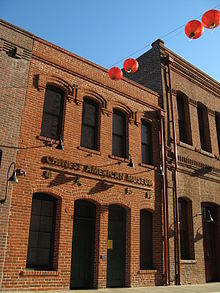History of Chinese Americans in Los Angeles: Difference between revisions
WhisperToMe (talk | contribs) |
WhisperToMe (talk | contribs) |
||
| Line 32: | Line 32: | ||
* Cho, Jenny and the Chinese Historical Society of Southern California. ''Chinatown and China City in Los Angeles'' (Postcard History). [[Arcadia Publishing]], 2011. ISBN 0738581658, 9780738581651. |
* Cho, Jenny and the Chinese Historical Society of Southern California. ''Chinatown and China City in Los Angeles'' (Postcard History). [[Arcadia Publishing]], 2011. ISBN 0738581658, 9780738581651. |
||
* Louis, Kit-King. ''A Study of American-born and American-reared Chinese in Los Angeles''. [[University of Southern California]], 1931. |
* Louis, Kit-King. ''A Study of American-born and American-reared Chinese in Los Angeles''. [[University of Southern California]], 1931. |
||
* Li, Wei (Department of Geography, [[University of Connecticut]]). "]http://usj.sagepub.com/content/35/3/479.abstract Anatomy of a New Ethnic Settlement: The Chinese Ethnoburb in Los Angeles]." ''[[Urban Studies]]''. [[SAGE Journals]], March 1998 vol. 35 no. 3. 479-501. doi: 10.1080/0042098984871 . |
|||
* Zesch, Scott. ''The Chinatown War: Chinese Los Angeles and the Massacre of 1871''. [[Oxford University Press]], June 29, 2012. ISBN 019975876X, 9780199758760. |
* Zesch, Scott. ''The Chinatown War: Chinese Los Angeles and the Massacre of 1871''. [[Oxford University Press]], June 29, 2012. ISBN 019975876X, 9780199758760. |
||
* Wu, Frances Yu-tsing. ''Mandarin-speaking Aged Chinese in the Los Angeles Area: Needs and Services''. |
* Wu, Frances Yu-tsing. ''Mandarin-speaking Aged Chinese in the Los Angeles Area: Needs and Services''. |
||
Revision as of 10:03, 11 March 2014

There is a historic population of Chinese Americans in Los Angeles and Greater Los Angeles.
History
The historian William Mason stated that the first Chinese in Los Angeles were Ah Luce and Ah Fou, who arrived in 1850.[1] In his memoirs, Harris Newmark stated that the first Chinese person was the servant of his uncle, Joseph Newmark.[2]

The Chinese massacre of 1871 caused deaths of Chinese individuals in Los Angeles. By 1900 there were about 3,000 Chinese in the city. Most residents of the old Chinatown came from Sanyi (San Yup) and Siyi (Sze Yup) in Guangdong. The Old Chinatown began to decline as more Chinese left. Many moved to East Adams around the 1920s and 1930s. The Los Angeles Union Passenger Terminal, built in 1933, was built over much of the former Old Chinatown, so a new Chinatown was established after Peter SooHoo Sr. and Herbert Lapham, an agent for the Santa Fe Railway, negotiated a land purchase for what would become the new Chinatown.[3]
Christine Sterling, a civic leader, developed "China City," a tourist attraction which opened in 1938. Chinese working there also lived there. After two fires, "China City" decayed and was gone by the 1950s. To make way for the Hollywood Freeway, almost all of the remainder of old Chinatown was destroyed in 1951. The remaining portions were parts of Sanchez Alley and Garnier Block.[4]
More Chinese, especially those from Hong Kong, immigrated to Los Angeles after the Immigration and Nationality Act of 1965 (Hart-Cellar Act) passed. By the end of the 20th Century many Chinese began moving to suburbs such as Monterey Park, Alhambra, Arcadia, and Rosemead.[4] By 2013, large numbers of ethnic Chinese moved into communities in the San Gabriel Valley, including San Gabriel, San Marino, and Walnut.[5]
Geography
Institutions
The Chinese Historical Society of Southern California is located in the region.
Recreation

The Chinese American Museum is located in Downtown Los Angeles.
References
- Cho, Jenny and the Chinese Historical Society of Southern California. Chinatown in Los Angeles. Arcadia Publishing, 2009. ISBN 0738569569, 9780738569567.
- Estrada, William David. The Los Angeles Plaza: Sacred and Contested Space. University of Texas Press, February 17, 2009. ISBN 0292782098, 9780292782099.
Notes
- ^ Estrada, p. 72.
- ^ Estrada, p. 71-72.
- ^ Cho and the Chinese Historical Society of Southern California, Chinatown in Los Angeles, p. 7.
- ^ a b Cho and the Chinese Historical Society of Southern California, Chinatown in Los Angeles, p. 8.
- ^ Medina, Jennifer. "New Suburban Dream Born of Asia and Southern California." The New York Times. April 28, 2013. Retrieved on March 11, 2014.
Further reading
- Cho, Jenny and the Chinese Historical Society of Southern California. Chinatown and China City in Los Angeles (Postcard History). Arcadia Publishing, 2011. ISBN 0738581658, 9780738581651.
- Louis, Kit-King. A Study of American-born and American-reared Chinese in Los Angeles. University of Southern California, 1931.
- Li, Wei (Department of Geography, University of Connecticut). "]http://usj.sagepub.com/content/35/3/479.abstract Anatomy of a New Ethnic Settlement: The Chinese Ethnoburb in Los Angeles]." Urban Studies. SAGE Journals, March 1998 vol. 35 no. 3. 479-501. doi: 10.1080/0042098984871 .
- Zesch, Scott. The Chinatown War: Chinese Los Angeles and the Massacre of 1871. Oxford University Press, June 29, 2012. ISBN 019975876X, 9780199758760.
- Wu, Frances Yu-tsing. Mandarin-speaking Aged Chinese in the Los Angeles Area: Needs and Services.
